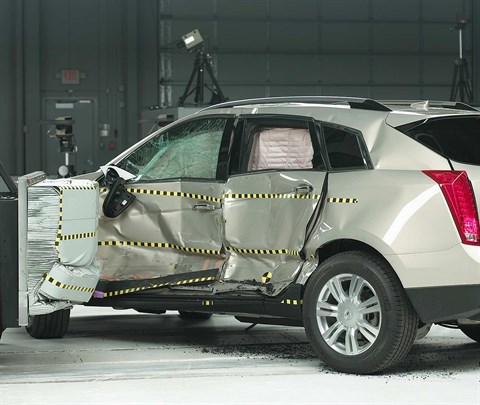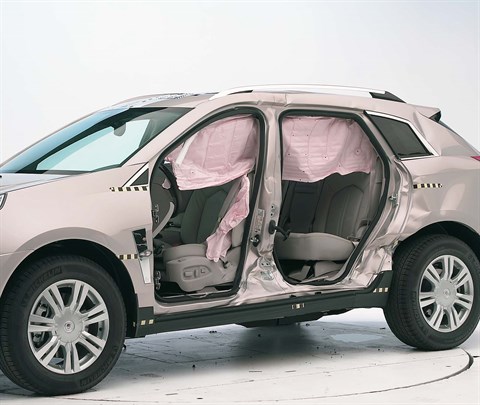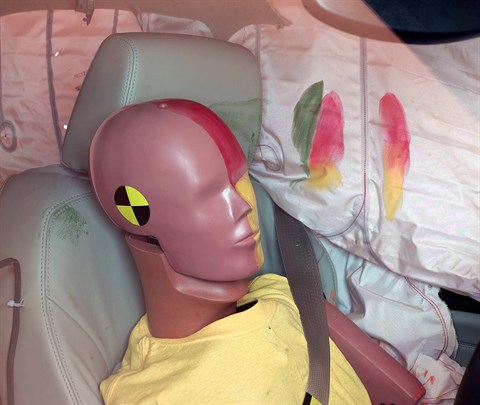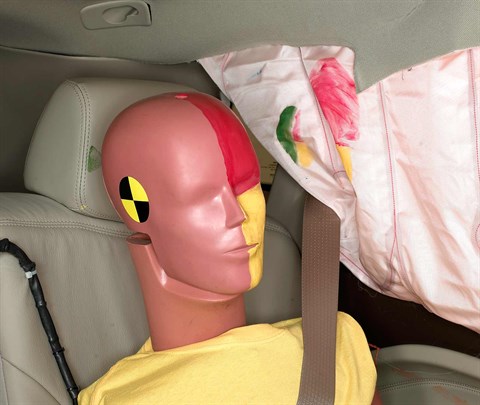Moderate overlap front: original test
Rating applies to 2010-16 models
Tested vehicle: 2010 Cadillac SRX 4-door 4wd
The Cadillac SRX was redesigned for the 2010 model year, and the Saab 9-4X was introduced in the 2011 model year. Both are structurally related to the Chevrolet Equinox and GMC Terrain. Frontal ratings are assigned by the Institute based on a test on an SRX conducted by General Motors.
| Evaluation criteria | Rating |
|---|---|
| Overall evaluation | |
| Structure and safety cage | |
| Driver injury measures | |
| Head/neck | |
| Chest | |
| Leg/foot, left | |
| Leg/foot, right | |
| Driver restraints and dummy kinematics | |
Side: original test
Rating applies to 2010-16 models
Tested vehicle: 2010 Cadillac SRX Luxury 4-door 4wd with front and rear head curtain airbags and front seat-mounted torso airbags
The Cadillac SRX was redesigned for the 2010 model year, and the Saab 9-4X was introduced in the 2011 model year. Both are structurally related to the Chevrolet Equinox and GMC Terrain.
| Evaluation criteria | Rating |
|---|---|
| Overall evaluation | |
| Structure and safety cage | |
| Driver injury measures | |
| Head/neck | |
| Torso | |
| Pelvis/leg | |
| Driver head protection | |
| Rear passenger injury measures | |
| Head/neck | |
| Torso | |
| Pelvis/leg | |
| Rear passenger head protection | |

View of the vehicle and barrier just after the crash test.

View of the vehicle after the crash with doors removed, showing the side airbags and damage to the occupant compartment.

Smeared greasepaint shows where the driver dummy's head was protected from being hit by hard structures by the side curtain airbag.

Smeared greasepaint shows where the rear passenger dummy’s head was protected by the side airbag.
Roof strength
Rating applies to 2010-16 models built after May 2010
Tested vehicle: 2010 Cadillac SRX Luxury 4-door 4wd
| Overall evaluation | |
|---|---|
| Curb weight | 4,505 lbs |
| Peak force | 18,652 lbs |
| Strength-to-weight ratio | 4.14 |
Head restraints & seats
Seat type: Power seats with lumbar
| Overall evaluation | |
|---|---|
| Dynamic rating | |
| Seat/head restraint geometry |
About the head restraint & seat test
Currently, IIHS tests apply only to front seats.
Front crash prevention: vehicle-to-vehicle
Ratings are given for 2 different trim variations available on this vehicle.
Child seat anchors
Rating applies to 2015-16 models
| Evaluation criteria | Rating |
|---|---|
| Overall evaluation | |
| Vehicle trim | Performance Collection |
| Seat type | leather |
This vehicle has 2 rear seating positions with complete child seat attachment (LATCH) hardware.
It has 1 additional seating position with a tether anchor only.
| Evaluation criteria | Rating |
|---|---|
| Overall evaluation | |
| Vehicle trim | Performance Collection |
| Seat type | leather |
| Rating icon | Rating |
|---|---|
| G | Good |
| A | Acceptable |
| M | Marginal |
| P | Poor |
| Seating positions that rely on borrowed lower anchors or have only a tether anchor available are not rated. | |
thether anchor symbol | Tether anchor |
lower anchor symbol | Lower anchors |
| Lower anchor(s) can be borrowed from adjacent positions(s) | |
| No hardware available |
Details by seating position
| Position | Rating |
|---|---|
| 1 | |
| Tether anchor | |
| easy-to-find location | |
| other hardware could be confused for anchor | |
| Lower anchors | |
| too deep in seat | |
| not too much force needed to attach | |
| difficult to maneuver around anchors | |
| 2 | |
| Tether anchor | |
| easy-to-find location | |
| no other hardware could be confused for anchor | |
| Lower anchors | |
| none available | |
| 3 | |
| Tether anchor | |
| easy-to-find location | |
| other hardware could be confused for anchor | |
| Lower anchors | |
| too deep in seat | |
| not too much force needed to attach | |
| difficult to maneuver around anchors |
